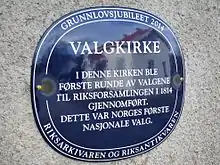Election church
An election church (Norwegian: valgkirke) is a term used for approximately 300 churches in Norway that were used as polling stations during the elections to the Norwegian Constituent Assembly at Eidsvoll in 1814.[1] The churches were used because they were the natural center of public life for most places in the country, and because the parishes were the basic units of the electoral system.

The parish priest was the chief official in the local community, and it was usually the parish priest that administered the elections. The elections were essentially indirect elections, in which an elector was first elected to the assembly or county council. The election assembly, which also took place in a central church, then chose the representative to send to Eidsvoll. In some small towns with only one congregation, the selection took place through direct voting. The first elections took place on a general day of prayer declared on Friday, February 25, 1814.[2][3]
Many of these churches have been lost since 1814. Some have burned, but most of those that are gone were torn down and replaced by new churches. About 190 election churches are preserved.[4] On the 200th anniversary of the vote in 2014, the National Archives and the Directorate for Cultural Heritage collaborated to label the churches with blue plaques[4] and to reprint facsimiles of the documents stating the addresses and authority of these churches.
References
- Lie, Yngve (February 22, 2014). "Valgkirke i 1814". Aura Avis. Retrieved November 25, 2018.
- Glenthøj, Rasmus; Nordhagen Ottosen, Morten. Experiences of War and Nationality in Denmark and Norway, 1807–1815. p. 215.
- Torgerson, Samuel (January 1918). "Norway's Struggle for Freedom". Quarterly Journal of the University of North Dakota: 121.
- Hagerud, Trond (2012). "Vinger kirke, valgkirke for Konge og Fedreland". Gamle Øvrebyen vel. Retrieved November 26, 2018.